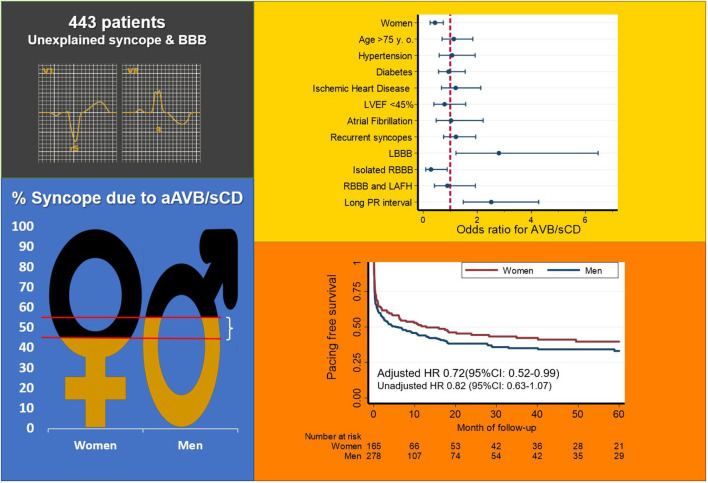- Record: found
- Abstract: found
- Article: found
Sex-Related Differences in Patients With Unexplained Syncope and Bundle Branch Block: Lower Risk of AV Block and Lesser Need for Cardiac Pacing in Women

Read this article at
Abstract
Objective
To analyze if there are sex-related differences in patients with unexplained syncope and bundle branch block (BBB).
Background
Despite increasing awareness that sex is a major determinant of the incidence, etiology, and the outcomes of different arrhythmias, no studies have examined differences in presentation and outcomes between men and women with syncope and BBB.
Methods
Cohort study of consecutive patients with unexplained syncope and BBB was included from January 2010 to January 2021 with a median follow-up time of 3.4 years [interquartile range (IQR) 1.7–6.0 years]. They were evaluated by a stepwise workup protocol based on electrophysiological study (EPS) and long-term follow-up with an implantable cardiac monitor (ICM).
Results
Of the 443 patients included in the study, 165 (37.2%) were women. Compared with men, women had less diabetes (25.5 vs. 39.9%, p = 0.002) and less history of ischemic heart disease (IHD; 13.3 vs. 25.9%, p = 0.002). Left bundle branch block (LBBB) was more frequent in women (55.2 vs. 27.7%, p < 0.001) while right bundle branch block (RBBB) was more frequent in men (41.5 vs. 67.7%, p < 0.001). His to ventricle (HV) interval in the EPS was shorter in women (58 ms [IQR 52–71] vs. 60 ms [IQR 52–73], p = 0.035) and less women had an HV interval longer than 70 ms (28.5 vs. 38.1%, p = 0.039), however, EPS and ICM offered a similar diagnostic yield in both sexes (40.6 vs. 48.9% and 48.4% vs. 51.1%, respectively). Women had a lower risk of developing atrioventricular block (AVB) (adjusted odds ratio [OR] 0.44–95% CI 0.26–0.74, p = 0.002) and of requiring permanent pacemaker implantation (adjusted hazard ratio [HR] 0.72–95% CI: 0.52–0.99, p = 0.046). The mortality rate was lower in women (4.5 per 100 person-years [95% CI 3.1–6.4 per 100 person-years] vs. 7.3 per 100 person-years [95% CI 5.9–9.1 per 100 person-years]).
Conclusions
Compared to men, women with unexplained syncope and BBB have a lower risk of AVB and of requiring cardiac pacing. A stepwise diagnostic approach has a similar diagnostic yield in both sexes, and it seems appropriate to guide the treatment and avoid unnecessary pacemaker implantation, especially in women.
Graphical Abstract
Risk of AVB and need for cardiac pacing. Left: Percentage of patients diagnosed with aAVB/sCD in both sexes. Right-top: Multivariate logistic regression analyses for risk of aAVB/sCD. Odds ratio and 95% CI are plotted. Right-bottom: Kaplan-Meier pacemaker-free survival estimates curves in both sexes. aAVB/sCD, advanced atrio-ventricular block or severe conduction disturbances; HR, hazard ratio; CI, confidence interval; y.o, years old; IHD, ischemic heart disease; LVEF, left ventricular ejection fraction; BBB, bundle branch block; LBBB, left bundle branch block; RBBB, right bundle branch block; LAFB, left anterior fascicular block.

Related collections
Most cited references30
- Record: found
- Abstract: not found
- Article: not found
2018 ESC Guidelines for the diagnosis and management of syncope
- Record: found
- Abstract: found
- Article: not found
Incidence and prognosis of syncope.
- Record: found
- Abstract: not found
- Article: not found